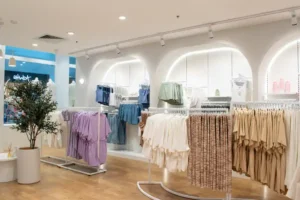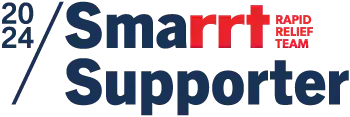You have a small space in the exhibition in which to achieve your goals.
It’s logical then, that that space (your booth) is designed to maximise the likelihood of achieving your goals.
Your booth has to capture the attention of passer-by’s and draw people who are likely customers in.
Here are the main dos and don’ts of booth design:
- Do study your budget and see how much you can afford to do.
- Do make your brand clear. People want to know who you are.
- Do make it obvious what you do, and how you do it.
- Do design your booth for comfort and interest. Encourage visitors to stay. The longer they stay, the more inclined to buy they become.
- Do have video demonstrations running continuously – these will be another salesperson.
- Do look for portable exhibition equipment. The less time you need to set it up, the less you will stress. Hiring tradesmen to help is not an attractive prospect for most!
- Don’t provide a path right through your booth if you are on a corner. It will become a thoroughfare of disinterested people.
- Don’t settle for the polished concrete of a standard exhibition floor. Hire a unique and comfortable floor covering – trade show attendees have notoriously sore feet!
- Don’t have a wall or counter across the main opening. You will lose a lot of visitors who feel threatened by the blockade.
- Don’t neglect to design your booth vertically. Remember visitors will be of varying heights. Elevate items if necessary.
- Don’t have storage areas on full view. This is unprofessional.
- Don’t copy competition. For you to succeed you must stand out. Copying your competitor’s booth is the best way to lose the interest of passer-by’s.
Sketch a design of your finished booth and write a checklist of items you will need. So the look and standard is constant, source as many items from one supplier as you can. Doing this will save you a deal of stress and freight charges as well.
Remember, there are suppliers who will be happy to help out with the design of your booth (ourselves included!) so if you get stuck please call.
When preparing for your trade show there is one bit of advice more valuable than any other:
Expect the unexpected.
The event will very rarely go according to plan, and when the unexpected hitch occurs, your preparation, or lack thereof, becomes obvious.
Now is the time to write a list of everything you can possibly think of that will require checking before, during and after the show.
Consider these (by no means comprehensive) factors:
Transport for your exhibition equipment. If your budget permits, leave this to the experts. There are companies out there who specifically assist in getting your booths, counters and stages to and from the show. Some even have long term storage facilities. But you need to arrange it now.
Literature quantities and storage. Check that there will be enough brochures and catalogues for the whole show period. Are there storage options if you overstock? How do you plan to display your literature at the event?
Accommodation and transport for staff. Book all tickets and make sure staff members know the details of their travel. Have tickets and reservations readily accessible. Check all hotel bookings and ask for a map of the area if it is an area you are unfamiliar with. Ensure all of the staff has maps as required.
Do you have a timetable of the event? Create one, and mark in staff shifts. Confirm staff availability. Timetable deliveries, installation and set-up of the booth and any other props you may have.
Coffee will become an essential resource during the exhibition. Locate your nearest coffee shop, or facilities for making coffees, now to save you time during the show.
Lighting and electricity are obvious needs, but check and recheck their availability. Will you need extension cords? Are you taking payments for anything during the show? Eftpos and credit card facilities will be necessary, along with a printer (for information and invoices) and a computer.
You never know when extra technology storage devices will come in handy. Pack extra external hard drives and usbs – and assume one of everything will fail J.Take a (or 2) internet dongles for your computer – the exhibition is unlikely to have free internet facilities, and if they do they may be unreliable.
These points may start you thinking about what you need, but your own list will obviously be for your individual company and exhibition. Remember, details that you cannot imagine causing a problem, will. However, doing your best in terms of preparation means you have less in the way of oversights at the show.
A tradeshow only pays off if you make an effort to advertise that you’re going. You don’t need an enormous advertising budget for this, just some strategy. Answer the 5 Big Questions and you’re on your way to success:
WHO
Who do you plan to advertise to? It’s great to tell your customers, but you must reach prospects as well.
Think about what relevant data you have on prospective customers. Can you obtain a list of registered attendees to target? Is there an industry association that you can get lists from?
WHAT
Clients may not, but prospects need more than “Come and visit us at XYZ Trade Show” to lure them to your booth. What added incentive will you offer? Make them feel like they’re missing out if they don’t take you up.
Ideas:
· Free Products at your stall
· Free Consultations after the event or during the event
· Competitions during the event
· Free Publicity during or after the event
· Discounts on purchases before, during or after for RSVPs
· A celebrity to meet at your stall
· Demonstrations during the event
· Free tickets to the show
WHERE
Where will you target in your advertising?
It’s been said before on this blog; restrict your advertising efforts to approximately 300km around the location of the event. Targeting people too far away is a waste of your budget and their time.
Consider the locations of your prospect carefully. Make maps to the show readily available.
WHEN
When will you advertise your show? We suggest a three month build-up, but exercise common sense (!).
Give people time to register attendance, but don’t give them so much time that they forget about it. A good rule of thumb is to do your broader-reach marketing earlier, and your more specific marketing (such as telemarketing) closer to the event.
However, promote the event on your website for as long as possible, so repeat visitors are reminded. Make a separate “Event” Page, if necessary, with all the details clearly noted.
HOW
How do you plan to advertise? Here are some methods and their relative advantages and disadvantages:
| Method of Advertising | Advantage | Disadvantage |
| Visiting Businesses & Personally Inviting Them | Very Specific High likelihood of take-up | Time-consuming You won’t cover a lot of people |
| Telemarketing to Targeted Group | Specific & easily individualised Very low cost Can be done by anyone | Prospects, particularly, aren’t likely to take up, as it can seem ‘salesy’ |
| Emailout to Targeted Group | Can target large volumes Can be low cost | Can be somewhat time-consuming to create an effective email May not be read |
| Mailout to Targeted Group | Can target large volumes Can be memorable & not overlooked | May not get to recipient May be expensive |
| Print Advertising in Trade Magazine | Could pull in people you weren’t able to contact any other way. Can be memorable | Not very specific Can be expensive |
| On your website | Good way to encourage already interested people Not necessarily high cost | If your site doesn’t attract many visitors it won’t be seen by many people |
| PR – Media Release | Inexpensive Reaches large volumes of people | Has to be written in a memorable manner to catch attention Not targeted release |
Do combination of these techniques for the greatest success, and remember to keep your end goal in mind at all times.
| It is a fact universally acknowledged that every business decision you make should be profit based. After extensive market research you have decided money put into a tradeshow is money well spent. You now need to measure your ROI. To measure your ROI you need to decide on a goal, or a prioritized list of goals, for the outcome of the trade show. Setting Goals is a part of Business Management 101, but here’s a quick refresher: Goals should be SMART –Specific, Measurable, Achievable, Realistic and Timebound. Your individual goals will vary by industry and your product or service range, but here are some ideas for Trade Show Outcomes you can tweak to suit yourself. Specifics Choose the area you need to work on – what is most important to you? Branding – We need to get our name out there. Publicity – No-one knows how much they need this new invention – we aim to tell them. Lead garnering – We want to expand our database. Lead nurturing – The salespeople need to know who to target. Or immediate sales? Measurable Here’s some examples of measurability:hand out X number of business cards/catalogues/brochuresdo X amount of demonstrations, with X number of people attending each oneX more people on our email list by the end of the showSecure X opportunities to quotesell X items during the showmake X dollars of sales during the showAchievable Ask yourself if the goal is possible? Do you have enough staff to back it up? Its great to stretch yourself, but if you promise people things, and then let them down, its worse than no promise at all. Realistic A trade show is a limiting environment – there are time, space and storage boundaries. Before you set helium-balloon goals, be realistic – do you have enough promotional products? Enough items? Enough storage? Timebound Well, obviously your strategy is limited by the time of the trade show. Not really. Don’t forget smaller ‘during’ goal periods such as ‘every hour’, ‘during lunch’ or ‘each day’. Consider as well, follow up periods after the show. Nobody likes ineffective spending but if you have a way of measuring success you can make decisions confidently. Taking the time to set goals before the show will certainly pay dividends afterwards. |







